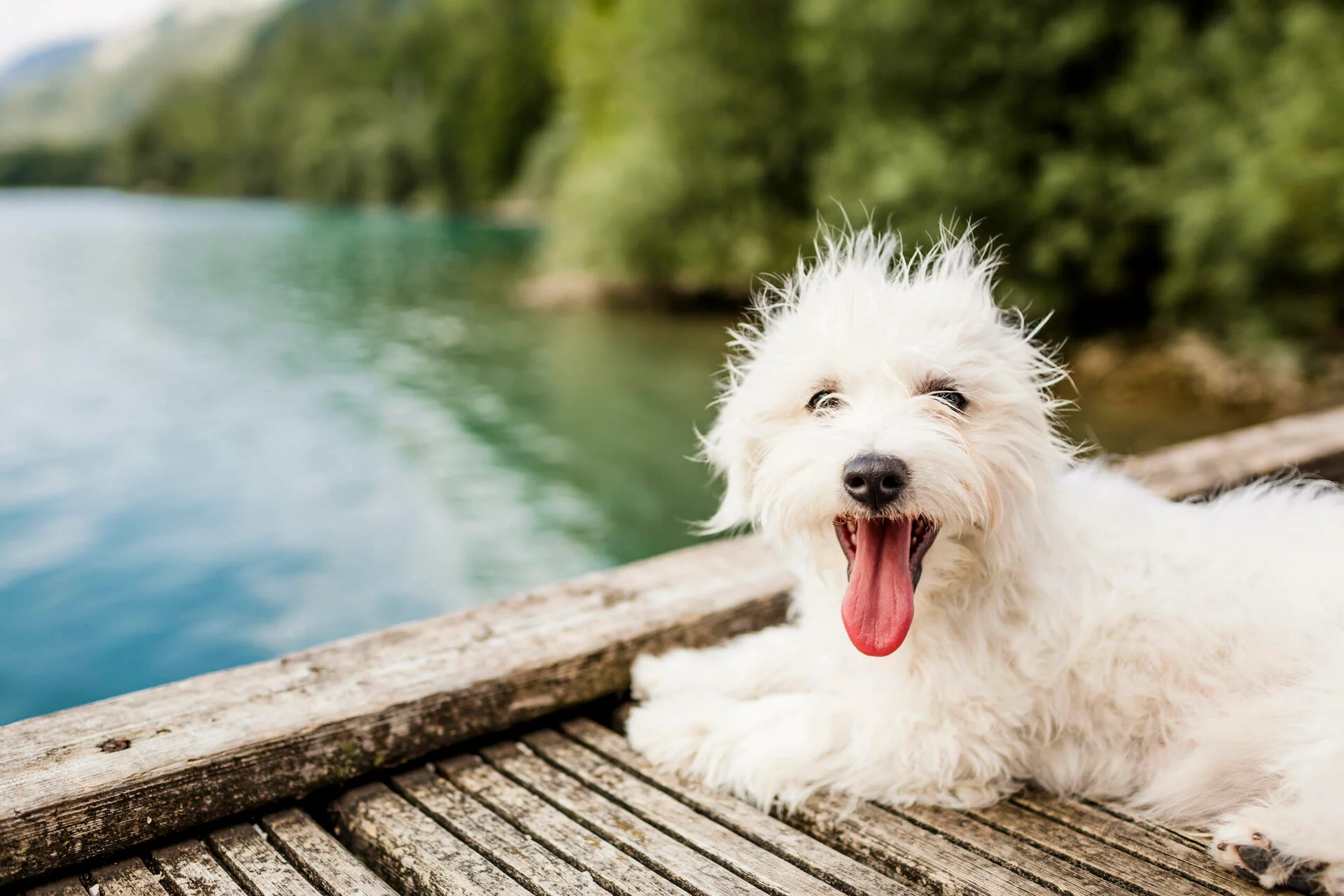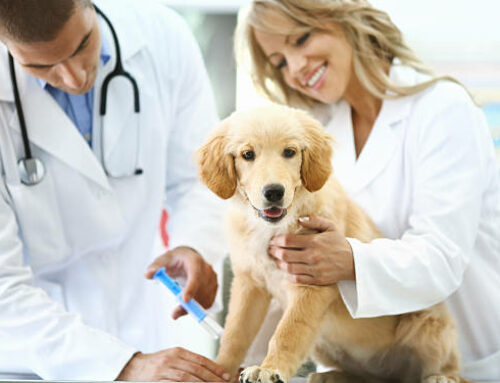Summer is a very exciting time for our canine friends. Whether they’re embarking on thrilling outdoor adventures, taking a relaxing dip in the sea or simply basking in the sun from the safety of your back garden, the warmer weather gives them the chance to enjoy their lives to the fullest. However amongst all the fun, high temperatures and new environments can also pose some substantial dangers and health risks. From heatstroke to harmful diseases carried by ticks and fleas, you’ll want to protect your pet from seasonal hazards this year. In this informative guide, we discuss everything you need to know about keeping your dog safe this summer.
High temperatures
Even for dogs who seem to thrive when the sun comes out, high temperatures can cause serious health risks:
Dehydration
Dogs can become dehydrated when more fluids leave the body than it takes in. They lose fluid through panting, urination and even sweat evaporating through their paws.
Signs of dehydration in dogs you should look out for include:
- Panting
- Dry gums and nose
- Thick saliva
- Lethargy
- Sunken eyes
- Loss of elasticity in the skin
Remember, you should be keeping your dog consistently hydrated throughout the day.
Heatstroke
Heatstroke can be the serious and often fatal result of a dog’s prolonged exposure to excessive heat. Heatstroke typically occurs when high ambient temperature overcomes the dog’s ability to dissipate heat – the longer the exposure, the more dangerous for your pet. Dogs have a considerably more serious reaction to heatstroke than humans, so it’s important to spot symptoms quickly and act fast.
Early stages of heatstroke include:
- Heavy panting
- Rapid breathing
- Excessive drooling
- Bright red gums and tongue
- Difficulty maintaining balance
- Advanced Stages:
Advanced stages of heatstroke include:
- White or blue gums
- Lethargy or unwillingness to move.
- Uncontrollable urination or defecation
- Laboured, noisy breathing
- Shock
If your dog exhibits signs of heatstroke, you should try to immediately cool them down. Cooling methods include getting them into the shade, spraying them with cool or tepid water, and fanning them. Meanwhile, severely affected dogs will require fluids, medication, support, and oxygen.
Keep in mind that the best remedy for heatstroke is prevention. You should be limiting how long your dog works or exercises in hot weather.
Keeping your dog cool
While these risks can seem extremely worrying, with the correct care and precautions your dog can still enjoy the warmer weather safely.
Here’s some top tips for keeping your dog cool in soaring temperatures:
- Make sure your dog has access to clean water at all times, ideally a large bowl filled to the brim. Carry water and a bowl with you on walks.
- Give your dog a shady spot to hang out on hot days or keep them inside where there’s air-conditioning.
- On hot days, walk your dog during the cooler parts of the day, in the early morning and late evening.
- Fill a child-size paddling pool or pool designed for dogs with fresh water for your dog to cool off in.
- Avoid exposing your dog to hot asphalt or sand, which can burn their paws, for any prolonged period.
- Take particular care when dealing with short nosed dogs such as bull breeds, boxers, pugs, older dogs and puppies, and those that are overweight. These dogs can quickly get heatstroke in high temperatures, even on a leisurely stroll.
Travelling in summer with your dog
If you’re planning on going on holiday, it’s likely that you will bring your furry friend with you. Whether you are travelling by air or car, there are certain things you should keep in mind before setting off on your journey:
Air
- You should check the guidelines provided by your airline before flying anywhere with your dog. Some dogs will only be allowed to fly in the early morning or evening, due to the dangers associated with hot weather.
- Put ice packs or a cooling mat in the dog’s crate if you’re flying a dog overseas.
- Provide a container of fresh water, as well as a container of frozen water that will thaw over the course of the trip
Car
- Use a cooling pad as a bed or crate liner.
- Keep a spray bottle filled with water to spritz your dog with to cool them down.
- Put a sunshade on the car windows to block out the heat.
- Most importantly, never ever leave your dog alone in a car on a hot day. If you do see a dog unattended, you can call 999 for police guidance. Do not break into the car to free the dog yourself, as this could be classed as criminal damage.
Taking your dog to the beach
Going to the beach is an exhilarating experience for many canines. However, there are several health and safety considerations you should be keeping in mind before taking your dog on a seaside holiday. Here’s some things to consider before taking your dog to the beach:
- Be cautious about letting your dog off the lead. Some beaches have very strict rules concerning this, and you’ll want to avoid a fine. Additionally, if your dog is a little on the unruly side, letting them run amok among excitable or fearful small children may not be the best idea.
- Protect your dog against sunburn – limit your dog’s sun exposure during the day and apply sunscreen to their ears, nose, and coat before going outside.
- Running on the sand is a strenuous activity, so keep tabs on their exercise levels and make sure they are not overexerting themselves. A dog that is out of shape can pull a tendon or ligament, and running on wet sand can make their paw pads blister.
- Try to prevent your dog from drinking seawater, as the salt will make them sick.
- While some dogs are natural swimmers, don’t leave your pet unattended in the water. It may be worth putting your dog in a life jacket.
- Be wary of jellyfish and sea lice.
- Make sure you have plenty of fresh water on hand to keep your dog hydrated.
- Ensure your dog has a shady spot to rest if they get too hot or overwhelmed.
Ticks and fleas
What’s summer without plenty of coastal and countryside walks with your dog? These outdoor activities are a great way to spend quality time with your pooch – however, it’s also when your pet is most likely to come into contact with ticks and fleas.
Ticks
Ticks can be a real nuisance in summer. These spider-like, egg-shaped creepy crawlies are commonly found in woodland, grassland and heath areas. Ticks carry diseases such as Lyme disease so it’s important to remove any that get attached to your dog. This can be tricky, as you’ll want to avoid squeezing the tick’s body or allowing its head to get stuck inside your dog. The best method is twisting them off – you can also buy handy tick-removal devices to make this easier.
Fleas
Flea bites are annoying and itchy for most dogs, but if your dog is allergic to them then they can cause real discomfort and severe scratching, which can become infected. This is why you should invest in regular flea treatment – speak to your vet for good recommendations.
Dealing with allergies
Just as certain humans suffer perpetually from hayfever every summer, some dogs are particularly prone to seasonal allergies. These can cause substantial discomfort, so you’ll want to ensure your pet is treated as soon as possible.
Signs your dog suffers from seasonal allergies
While the reactions dogs have to allergens are slightly different from those of humans, there are several common symptoms you can look out for. These include:
- Itchy skin
- Recurrent ear infections
- Red, swollen eyes
- Runny nose
- Fits of sneezing
- Scatching
- Hives
- Excessive licking
Treating dogs for seasonal allergies
If you suspect your dog is suffering from seasonal allergies, the best thing to do is to speak to the vet. Your vet may recommend some medication to help your pet feel better and more comfortable during the summer. There are lots of different treatment options available, from tablets to skin supplements to medicated shampoos, and your vet will work with you and your pet to find the best combination for them.
Another option for treating your dog’s seasonal allergies is through nutrition. Certain therapeutic dog foods are specially formulated to help manage your dog’s skin allergies. These can be an excellent option to supplement or even replace the need for more expensive medications.
Reducing exposure to pollen and other allergens can also help – try to work out what time of year your dog reacts the worst to and reduce outdoor walks in grassy areas during this period.
If you’re concerned about your dog this summer, turn to Bay Vets. Our teams are made up of dedicated and enthusiastic individuals who are passionate about animals. From animal neutering to puppy vaccinations, our pet surgery provides an extensive range of services aimed at keeping your furry friends as healthy and happy as possible. Contact us by either emailing us at emailing info@bayvets.co.uk or by registering your pet online today.





